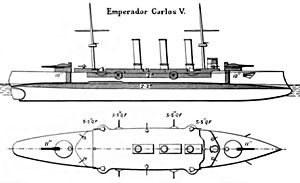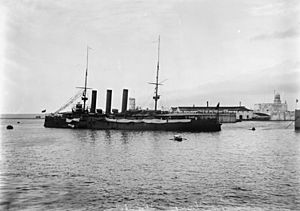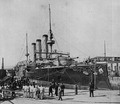Spanish cruiser Emperador Carlos V facts for kids
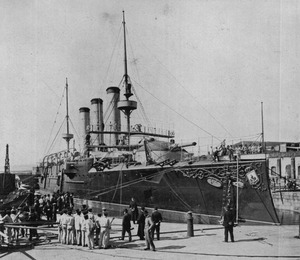
Armored cruiser Carlos V around 1898.
|
|
Quick facts for kids History |
|
|---|---|
| Name | Emperador Carlos V |
| Namesake | Charles V, Holy Roman Emperor |
| Builder | Vega-Murguia Shipyard, Cadiz, Spain |
| Laid down | 1892 |
| Launched | 13 March 1895 |
| Completed | 2 June 1898 |
| Decommissioned | 1922 |
| Stricken | 1932 |
| Fate | Scrapped 1933 |
| General characteristics | |
| Type | Armored cruiser |
| Displacement |
|
| Length |
|
| Beam | 67 ft 0 in (20.42 m) |
| Draft | 25 ft 0 in (7.62 m) mean |
| Installed power | 18,500 ihp (13,800 kW) (15,000 ihp (11,000 kW) on trials with natural draft) |
| Propulsion | 2-shaft, 4-cylinder vertical triple expansion |
| Speed |
|
| Complement | 600 officers and enlisted |
| Armament |
|
| Armor |
|
| Notes | Coal 1,200 tons (normal); 1,800 tons (maximum) |
Emperador Carlos V was a powerful armored cruiser that served in the Spanish Navy. It was part of the Spanish fleet from 1898 to 1933. This ship was special because it was built using money originally meant for smaller torpedo boats.
The design of the Emperador Carlos V was inspired by the British Blake class. It was known for being able to travel very long distances without needing to refuel. However, it did not have very thick armor for protection. When it was first built, it only had four 100 mm guns.
Contents
Building the Emperador Carlos V
The Emperador Carlos V was built at the naval shipyard in Cadiz, Spain. It was the largest ship constructed in Spanish shipyards during that time.
- Work on the ship began in 1892.
- It was officially launched into the water on March 13, 1895.
- The ship was fully finished and ready for service on June 2, 1898.
This ship was the only one of its kind. Different parts of the ship came from various countries:
- Its engines and boilers were made in Spain.
- Its armor came from Germany.
- Parts of its front and back were from Britain.
- Its gun turrets, which were added in France in 1897, were French.
The Emperador Carlos V had three funnels. It was not heavily armored, meaning its main protection came from its armored deck. Its two large 11-inch main guns were placed at the front and back of the ship. A key strength of the ship was its ability to travel long distances without stopping.
A Sad Event During Construction
A sad event happened the day before the Emperador Carlos V was launched. Another Spanish cruiser, the Reina Regente, sank. Its captain tried to cross the Strait of Gibraltar during a storm to attend the launching ceremony. Sadly, all 420 sailors and officers on board the Reina Regente died.
The Ship's Service History
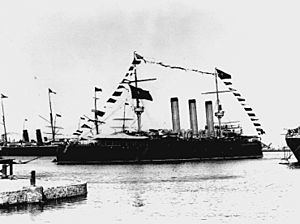
The Emperador Carlos V was very new when the Spanish–American War started in April 1898. Even though it was not fully ready, it was quickly put into service. It joined the 2nd Squadron, led by Rear Admiral Manuel de Camara. This squadron was ordered to sail to the Philippines. Their mission was to challenge the U.S. Navy's Asiatic Squadron. The American squadron had taken control of the waters around the Philippines after winning the Battle of Manila Bay.
Journey to the Philippines (and Back)
Admiral Camara's squadron included several ships:
- The Emperador Carlos V
- The battleship Pelayo
- Auxiliary cruisers Patiota and Rapido
- Destroyers Audaz, Osado, and Prosepina
- Transport ships Buenos Aires and Panay
The squadron left Cadiz on June 16, 1898. They passed Gibraltar the next day. On June 26, 1898, they reached Port Said, Egypt. They asked for permission to get more coal there. However, the Egyptian government said no on June 30, because they wanted to stay neutral in the war.
By the time Camara's squadron arrived at Suez on July 5, 1898, another Spanish squadron had been destroyed. This was Vice Admiral Pascual Cervera y Topete's squadron, which was defeated in the Battle of Santiago de Cuba. This meant the U.S. Navy's main forces were no longer busy blocking Santiago de Cuba. Spain became worried about its own coast. So, on July 7, 1898, the Spanish Ministry of Marine called Camara's squadron back home. The Emperador Carlos V returned to Spain. Camara's 2nd Squadron was officially ended on July 25, 1898. The Emperador Carlos V spent the rest of the war in Spanish waters and did not see any combat.
After the War
After the Spanish-American War, the Emperador Carlos V went on trips to show the Spanish flag in other countries. It attended naval events, including the coronation of King Edward VII of the United Kingdom in 1902. In 1914, the ship was present during the United States occupation of Veracruz in Mexico.
The Emperador Carlos V was taken out of service in 1922. It was removed from the navy's list in 1932. Finally, it was taken apart for scrap metal in 1933.
Images for kids
-
Carlos V in 1898, on the Suez canal.
See also
 In Spanish: Carlos V (1898) para niños
In Spanish: Carlos V (1898) para niños


